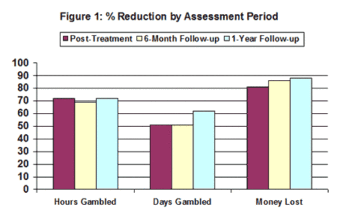By the time many people enter treatment for problem gambling, they often have amassed debt and done considerable damage to their interpersonal relationships. Early interventions might be successful in averting a large number of such crises. Robson, Edwards, Smith, & Colman (2002) recently published a program evaluation for the early intervention program ‘Gambling Decisions.’
Robson et al. describe ‘Gambling Decisions’ as a brief (i.e., 6-week) cognitive behavior treatment (CBT) program for early stage problem gamblers (i.e. less severe gambling problems). The program goals are somewhat flexible since it neither advocates abstinence nor controlled gambling. The overall program aims include: (1) reducing gambling and money spent, and (2) reducing conflict experienced by the gambler at home, work, and in the community. Key components of the program include: (1) discussing readiness to change, (2) using a decisional balance approach, (3) identifying risk triggers and coping strategies, (4) recording all gambling, and (5) examining potential gambling misconceptions.
Robson et al. conducted a one-year community trial for ‘Gambling Decisions.’ Two hundred twenty three individuals responded to program advertisements and participated in a phone interview that allowed counselors to screen applicants for eligibility. Specifically, to determine eligibility counselors asked individuals to respond to DSM-IV criteria using one of three categories of frequency: (1) occasionally, (2) often, and (3) almost all of the time. To restrict participation to early stage problem gamblers (i.e. individuals who have not developed severe gambling problems), the authors excluded individuals who responded “almost all of the time” to five or more DSM-IV items and referred them to an abstinence-based program. Inclusion criteria required that treatment seekers self-identify as having problems with gambling (Robson, personal communication) (1). Participants self-selected the format of their program (i.e., self-guided therapy + minimal counseling or group-guided therapy + weekly counseling) and the goal of their program (i.e., abstinence or controlled gambling). Of the 117 eligible participants, 60 (51%) (2) completed four assessments: (1) pre-treatment, (2) post-treatment, (3) 6-month follow-up and (4) 1-year follow-up. Participants used the timeline follow-back technique (Sobell & Sobell, 1992) to aid in the reporting of the amount of time and money they spent on gambling in the 4 weeks prior to each assessment period.
These results suggest that individuals who completed the Gambling Decisions program reduced and maintained their reductions in the amount of time they spent gambling and average amounts of money lost. These findings were observed even when the authors excluded abstainers from analysis.
The results of this study suggest that secondary prevention, prevention aimed at individuals prior to the development of severe problem gambling, might be beneficial. However, there are some limitations. Perhaps the most important limitation is that this study was not a randomized clinical trial. Consequently, we cannot determine whether the successes in this community trial are due to the program, changes in the natural course of gambling problems, or self-directed adjustments. Further, it is difficult to determine whether or not this program exerted influence on individuals’ behaviors or whether the observed changes resulted from the attributes of the volunteers. Finally, the techniques for participant exclusion remain untested and might not effectively distinguish individuals with severe gambling problems. The authors note that the 19 participants who dropped out before follow-up tended to gamble more at outset than participants did who did not drop out.
Nevertheless, researchers and treatment providers should pay more attention to early intervention efforts. Such efforts can occur at different periods in the progression of problem gambling, and exploring the effectiveness of programs at these different periods is a worthy effort. Preventative medicine is essential to the development of effective comprehensive public health efforts for problem gambling. As such efforts improve more people can avoid becoming problem gamblers.
Comments on this article can be addressed to Debi LaPlante.
Notes
1. Additional exclusion criteria included: suicidality, other serious mental health problems, criminal sentencing, excessive gambling spending, and alcoholism.
2. Thirty eight of the original 117 signed up to participate, but never attended or attended only one session. Nineteen dropped out before study completion.
References
Robson, E., Edwards, J., Smith, G., & Colman, I. (2002). Gambling Decisions: An early intervention program for problem gamblers. Journal of Gambling Studies, 18 (3),235-255.
Sobell, L. C., & Sobell, M. B. (1992). Timeline follow-back: A technique for assessing self-reported ethanol consumption. In J. Allen & R. Z. Litten (Eds.), Measuring alcohol consumption: Psychosocial and biological methods (pp. 41-72). Totowa, NJ: Humana Press.





